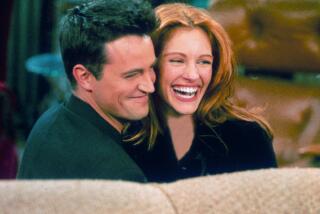Chris Hayward, 81; cartoon and TV writer, Emmy winner
- Share via
Chris Hayward, a television writer who developed the klutzy cartoon character Dudley Do-Right and helped imbue the rest of the Rocky and Bullwinkle gang with the same sense of silliness and satire, has died. He was 81.
Hayward, an Emmy winner who also helped create “The Munsters” for television, died of cancer Nov. 20 at his Beverly Hills home, said his wife, Linda.
Bullwinkle J. Moose and his zany friends came out of the Sunset Boulevard studios of Jay Ward, who warned against underestimating television viewers and encouraged his writers to “take potshots at everything,” Hayward once said.
“His philosophy was: ‘Just write sharp stuff for yourself and the audience will get it.’ It was very freeing,” Allan Burns, a “Bullwinkle” writer who became Hayward’s writing partner, said last week.
There was no such thing as a bad pun on “Rocky and His Friends,” which premiered on ABC in 1959 and was renamed “The Bullwinkle Show” when it moved to NBC in 1961. “The worse, the better,” Hayward told The Times in 1988.
The first episode Hayward co-wrote for the flying squirrel and his sidekick with the dimwitted voice was “Rue Britannia,” according to “The Moose That Roared” (2000), a history of the show. When the plot requires Bullwinkle to survive a week in the Abominable Manor in England, he says, “Shucks, I’ve been livin’ in an abominable manner all my life!”
The writers’ revelry in wordplay extended to other segments that filled out the half-hour show: “Fractured Fairy Tales” and “Aesop and Son,” irreverent sendups of classic stories and fables; “Peabody’s Improbable History,” in which a smart dog time-travels with a pet boy; and “Dudley Do-Right of the Royal Canadian Mounties,” a goofily inept hero whose nemesis is Snidely Whiplash.
When “Bullwinkle” first aired, “it was one of the hippest and most underappreciated programs on TV,” said Robert J. Thompson, a professor of pop culture at Syracuse University.
“Half the people watching it were kids who weren’t getting it. And the other half couldn’t believe what they were watching. There was stuff going on that was positively hallucinogenic.”
While recording dialogue, the cast rarely improvised, June Foray, who voiced Rocky and others, told The Times in 2003. “They were written so brilliant, we wouldn’t dare,” she said. “The only time I changed anything is when I put a ‘hokey smokes’ in,” which was one of Rocky’s trademark utterances.
Many of the fables were written by Hayward and another Ward veteran, Lloyd Turner. A penchant for puns is always front and center: “Barking dogs seldom bite,” Aesop says in one about a dog and his stolen false teeth. Junior, his son, retorts: “Nothing dentured, nothing gained,” the book recounted.
When Hayward and Turner were asked to reinvent the Do-Right character, which had been around since the late 1940s, Ward gave minimal instruction. “It’s about a stupid Mountie. Just have fun!” Hayward recalled in the book.
The character’s strong chin may have been a nod to Hayward’s own, his wife said. The strangulated voice belonged to Bill Scott, who also voiced Bullwinkle.
Reflecting Hayward’s affection for old movies, the Do-Right episodes had a melodramatic style. Hayward’s installments are distinguished by silent-film titles, including parodies of credits; one introduced Snidely Whiplash as being portrayed by “Madison A. Swill.”
For the Ward studio, Hayward thought up and co-wrote “Fractured Flickers,” a silent-film spoof that premiered in 1963. The 26 half-hour episodes scrambled silent films into new tales by re-editing footage and adding dialogue. “The Hunchback of Notre Dame” became the story of a sappy cheerleader named Dinky Dunstan while “Dr. Jekyll and Mr. Hyde” turned into a tale about soda pop.
“He was an amazing writer. I never knew where that offbeat sense of humor came from,” said Burns, who teamed with Hayward when they left Ward in the early 1960s.
After leaving the studio, the new writing team wanted to do a show “about a family that was just plain weird” in reaction to the wholesome families that populated television at the time, Burns said.
By the time “The Munsters” premiered on CBS in 1964, the idea had been twisted to showcase an everyday family of friendly, unassuming monsters.
The Writers Guild of America intervened and eventually the pair received monetary compensation and credit for helping to develop “The Munsters,” Burns said.
For their work on the CBS sitcom “He & She,” they received an Emmy in 1968. After writing for “Get Smart” (1965-70), the team split up. Burns went on to help create “The Mary Tyler Moore Show” in 1970.
Hayward turned to “Barney Miller,” an ABC series that satirized life in a precinct house and starred Hal Linden. When it premiered in 1975, The Times called it “the funniest new show since ‘MASH,’ ” and pointed out that Hayward and his co-producer, Danny Arnold, had written almost every word.
Born June 19, 1925, in Bayonne, N.J., Christopher Robert Hayward moved to Los Angeles when he was 17.
Encouraged by a night class in scriptwriting at Fairfax High School, Hayward went into television in the 1950s. He was soon working on Ward’s “Crusader Rabbit,” the first cartoon show created specifically for television.
While teamed with Burns at Ward’s studio, Hayward would tap his inner comedian by standing on a chair or table, painting acoustic ceiling tiles black with a tiny brush while being nothing short of hysterical.
Said his former partner: “He was the Michelangelo of comedy writers.”
In addition to his wife, Hayward is survived by his children, Laurel, Victoria and Tony, from a previous marriage that ended in divorce.
*
More to Read
The complete guide to home viewing
Get Screen Gab for everything about the TV shows and streaming movies everyone’s talking about.
You may occasionally receive promotional content from the Los Angeles Times.







